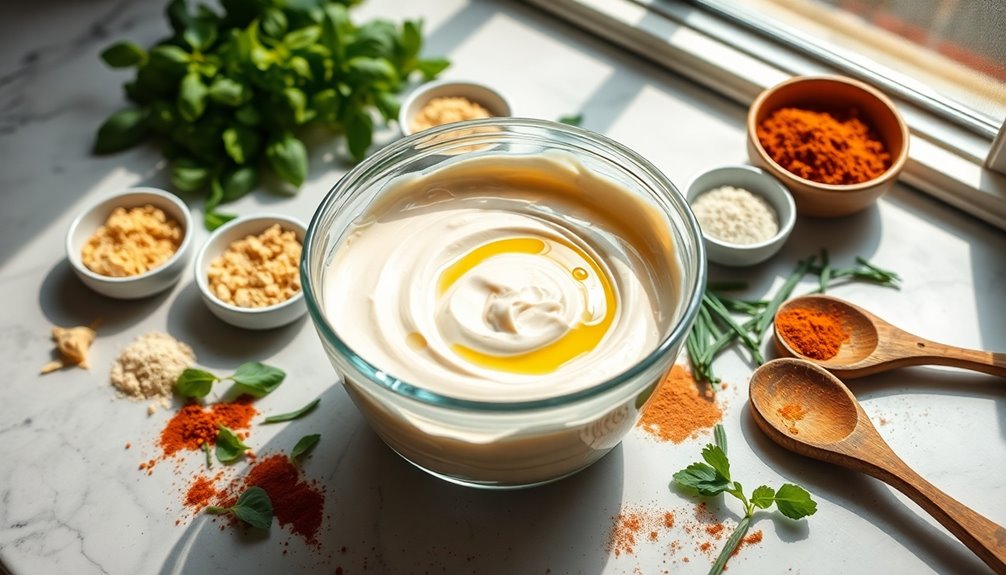You can create creamy vegan cheese at home with ease! Start by soaking nuts like cashews or almonds for an ultra-smooth base. Blend the soaked nuts with nutritional yeast, lemon juice, and your favorite herbs and spices for added flavor. If you want extra creaminess, toss in silken tofu or coconut cream. Adjust the blending time to achieve your desired consistency. For the best taste, allow your cheese to age in a cool spot using a breathable cover. Pair your creation with fruits, nuts, and crackers. There's so much more to explore in the art of vegan cheese-making!
Key Takeaways
- Soak nuts like cashews or almonds overnight to achieve a creamy texture for your vegan cheese base.
- Blend soaked nuts with nutritional yeast, lemon juice, and spices in a high-speed blender until silky smooth.
- Experiment with herbs and seasonings like garlic powder or smoked paprika to enhance the flavor profile of your vegan cheese.
- For a tangy touch, incorporate apple cider vinegar or nutritional yeast for added richness and B vitamins.
- Store the cheese in a cool place, using breathable coverings like cheesecloth to allow for flavor development and fermentation.
Understanding Vegan Cheese Basics
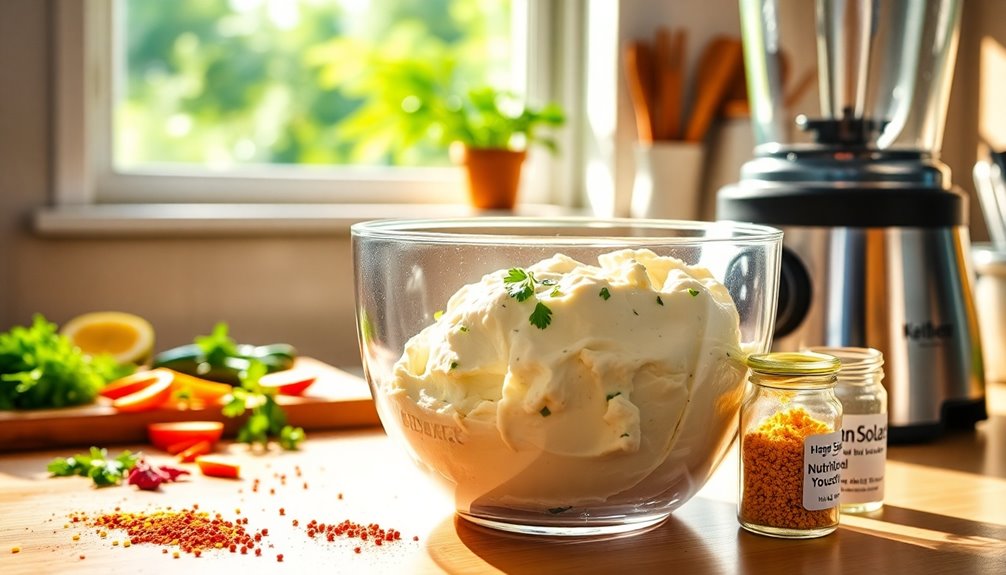
Vegan cheese is a delightful alternative that captures the creamy, rich flavors of traditional cheese without using any animal products. If you're looking to explore new tastes while adhering to a plant-based lifestyle, you're in for a treat. Understanding the basics of vegan cheese won't only satisfy your cravings but can also introduce you to a world of nutritional benefits.
One of the standout features of vegan cheese is its versatility. It can be crafted from a variety of bases, including nuts, seeds, and even vegetables. This means you can enjoy a range of textures and flavors, from creamy spreads to crumbly toppings. Each type of vegan cheese offers unique nutritional benefits. For instance, cashew-based cheeses are rich in healthy fats and vitamins, while those made from nutritional yeast provide a fantastic source of B vitamins, including B12, which is essential for anyone on a vegan diet. Additionally, incorporating plant-based foods into your diet can offer significant health benefits, making vegan cheese a flavorful choice for your meals.
Additionally, vegan cheese can be used in countless alternative ways. You can slather it on your favorite bread, sprinkle it over salads, or melt it into your pasta dishes for that comforting, cheesy goodness. It's a fantastic way to bring people together, whether you're hosting a gathering or enjoying a cozy meal at home. Embrace this delicious alternative, and you'll find that vegan cheese isn't just a substitute—it's a flavorful addition that helps you connect with others who share your passion for plant-based eating.
Essential Ingredients Needed
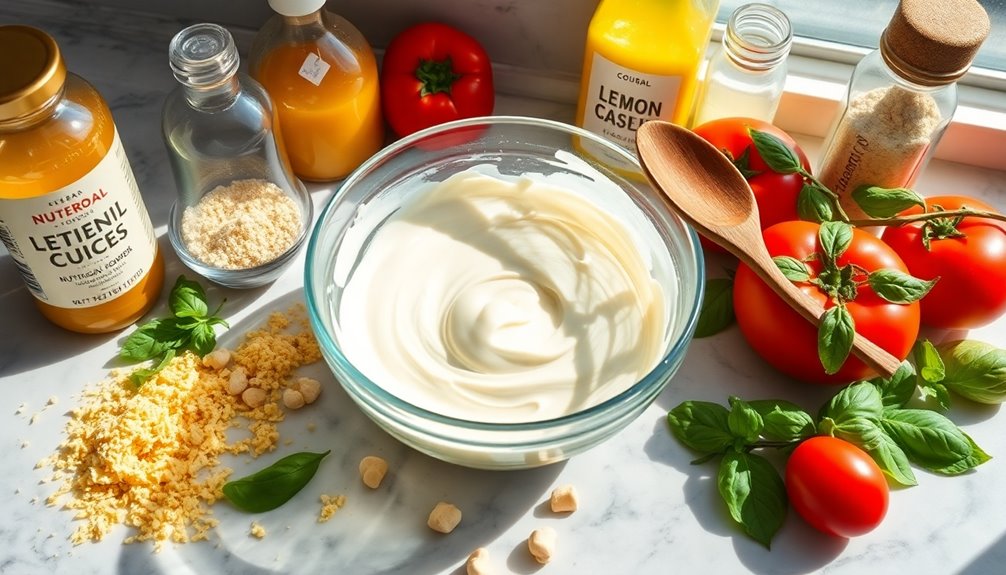
To whip up your own creamy vegan cheese at home, you'll need a few essential ingredients that come together to create rich, satisfying flavors.
First up, soaked nuts, like cashews or almonds, form the creamy base. They provide a wonderful texture and are packed with nutritional benefits, such as healthy fats, protein, and vitamins.
Next, you'll want to add some nutritional yeast. This ingredient not only brings a delightful cheesy flavor but also boosts your dish with B vitamins, making your vegan cheese not just delicious but also nutritious.
For tanginess, a splash of lemon juice or apple cider vinegar does wonders, giving your cheese that familiar zing that dairy-based cheeses have.
Herbs and spices are your best friends when it comes to enhancing flavors. Think garlic powder, smoked paprika, or fresh chives to add depth and variety.
If you're aiming for texture variations, consider incorporating silken tofu or a bit of coconut cream for a thicker consistency or blending in some water for a smoother spread. Additionally, using whole food sources of protein can enhance the nutritional profile of your vegan cheese, ensuring it supports a balanced diet.
Choosing the Right Nuts
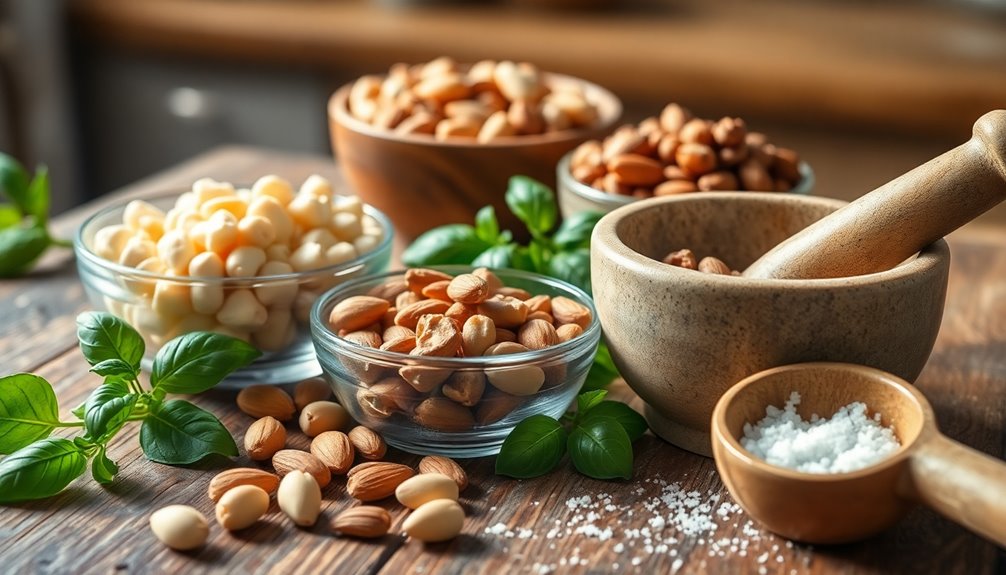
When it comes to crafting creamy vegan cheese, the choice of nuts plays a vital role in achieving that desired texture and flavor. Selecting the right nuts can elevate your homemade cheese, making it a delightful addition to your meals and gatherings. Here are four nuts that can transform your cheese-making experience:
- Cashews: Known for their creamy texture, cashews provide a rich base that blends seamlessly, offering a luxurious mouthfeel and a mild flavor that pairs well with many spices.
- Almonds: While a bit firmer than cashews, almonds can create a wonderful texture variation when blended. They also bring a nutty taste that complements a variety of dishes.
- Macadamia Nuts: These nuts are incredibly rich and buttery, lending a decadent creaminess to your vegan cheese. They're perfect for those who want to indulge their taste buds.
- Pine Nuts: With their unique, slightly sweet flavor, pine nuts can bring a delightful twist to your cheese. They also add a lovely creaminess when soaked and blended properly.
Soaking techniques are essential for all these nuts, as they help soften them, making blending easier and enhancing their nutritional benefits. As you experiment with different combinations, you'll discover exciting flavor pairings and texture variations that truly resonate with your culinary creativity. Additionally, embracing plant-based eating can lead to a longer, healthier life due to its numerous health benefits associated with plant-based diets.
Embrace this journey; you'll not only create delicious vegan cheese but also foster a sense of belonging within a vibrant community of plant-based enthusiasts.
Flavoring Your Vegan Cheese
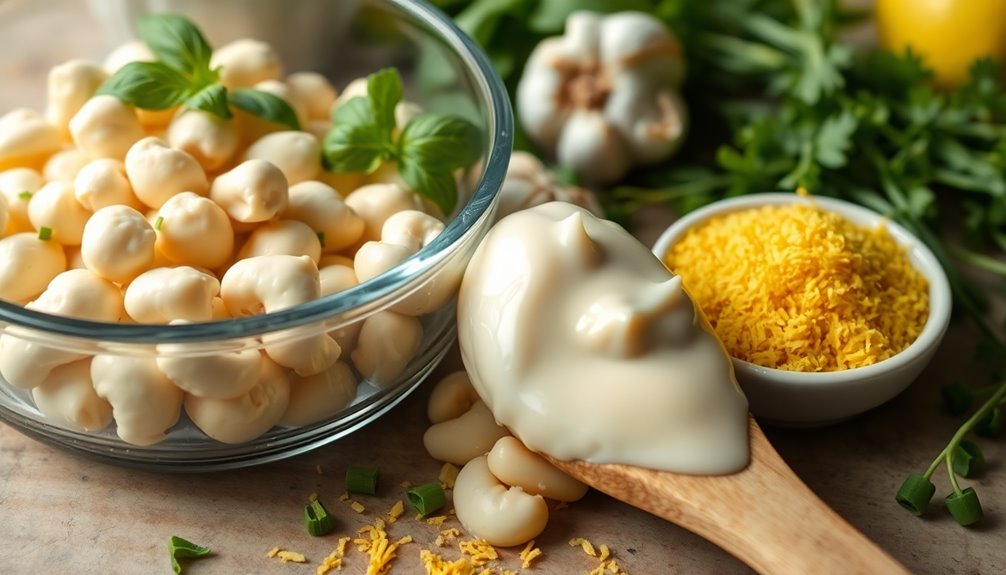
After selecting the perfect nuts for your creamy base, the next exciting step is infusing your vegan cheese with flavor. This is where your creativity can really shine! You've got a world of seasoning options at your fingertips, allowing you to craft a cheese that speaks to your taste buds and complements your favorite dishes.
Start by considering your texture preferences. Do you want a smooth, spreadable cheese or something a bit chunkier? For a creamy finish, you might blend in nutritional yeast for a cheesy, umami flavor, or a splash of lemon juice to add brightness. If you're craving a bit of kick, try incorporating garlic powder, onion powder, or even a hint of smoked paprika for depth.
Don't forget fresh herbs! Chopped chives, basil, or dill can elevate your cheese, making it feel fresh and vibrant. For a more adventurous twist, add sun-dried tomatoes or olives for an unexpected burst of flavor.
Taste as you go! This is your cheese, and you should feel free to adjust the ingredients until it feels just right. Whether you're serving it on a platter for friends or enjoying it solo, the right balance of flavors will bring your vegan cheese to life.
Step-by-Step Preparation
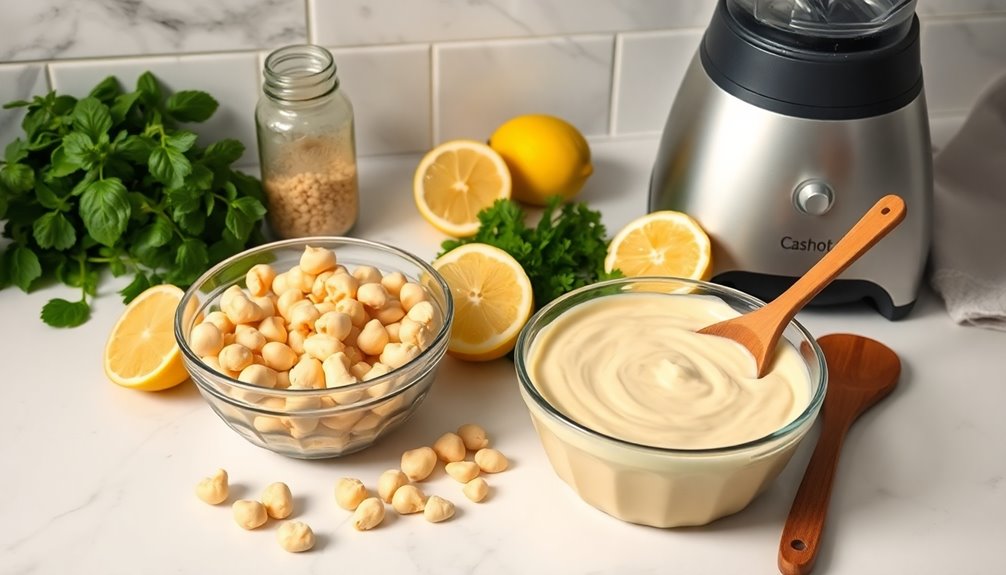
Creating your creamy vegan cheese at home is easier than you might think, and with just a few simple steps, you'll be ready to whip up a delicious spread. Get ready to impress your friends and family with something that not only tastes amazing but also brings everyone together!
Here's how you can prepare your vegan cheese:
- Gather Your Ingredients: Choose your base, like soaked cashews or almonds, and select your flavor variations, such as nutritional yeast, garlic powder, or fresh herbs. The right combination will set the tone for your cheese.
- Soak and Drain: If you're using nuts, soak them for at least 4 hours to achieve that creamy texture. This step is essential for avoiding any gritty mouthfeel. Texture tips: The longer you soak, the smoother your cheese will be!
- Blend to Perfection: Combine your soaked nuts with your chosen flavor variations in a high-speed blender. Blend until you achieve a silky consistency. If it's too thick, add a splash of water or plant-based milk to achieve your desired texture.
- Taste and Adjust: This is your moment! Taste your cheese and adjust flavors as needed. Want it tangier? A dash of lemon juice might do the trick. Additionally, incorporating mini bands for effective workouts can help maintain your fitness routine while enjoying your culinary creations.
Now, you're ready to enjoy your homemade creamy vegan cheese—perfect for spreading, dipping, or even stuffing! Share it at your next gathering and watch your loved ones rave about your culinary skills.
Blending Techniques for Creaminess
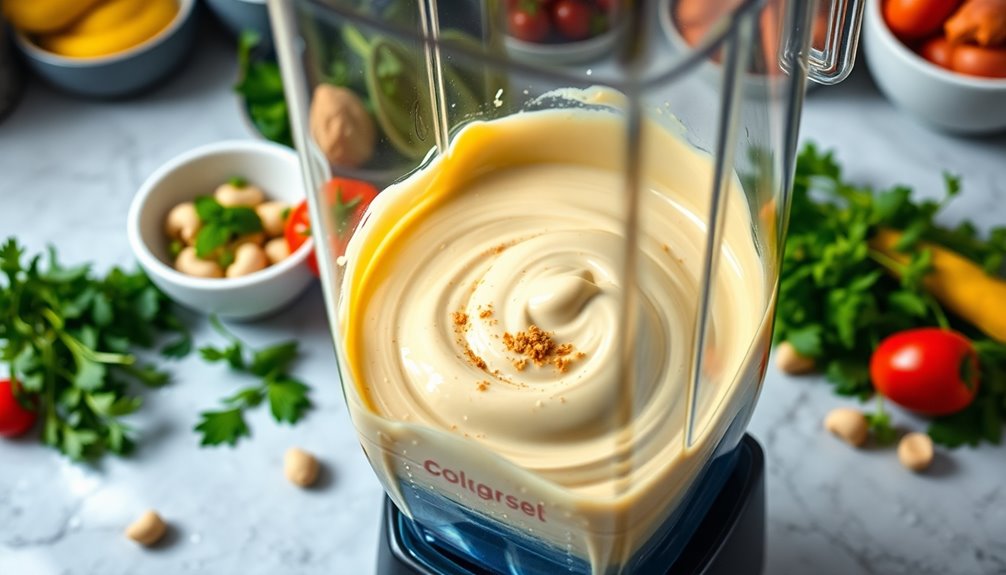
Achieving that perfect creamy texture in your vegan cheese relies heavily on effective blending techniques. The right approach can elevate your cheese from a bland mix to a luscious, spreadable delight. Start with a high-powered blender or food processor; these tools make a world of difference. They ensure that all your ingredients blend smoothly, creating that sought-after richness.
When blending, remember to add a splash of liquid—like almond milk or coconut cream—to enhance the texture. This small addition not only facilitates smoother blending but also reveals some creaminess secrets. Gradually incorporate your ingredients; start with softer items like soaked cashews, nutritional yeast, and lemon juice, then blend until silky.
If you find lumps, don't hesitate to scrape down the sides and blend a little longer—this is one of those texture tips that can make or break your cheese.
Don't rush the blending process. Take your time, and let the machine do its work. You might be surprised at how much smoother your mixture becomes with just a few extra minutes. If you're aiming for a specific texture, feel free to adjust the blending time accordingly. Furthermore, incorporating a custom keto diet plan can help you identify ingredient combinations that complement your vegan cheese.
Setting and Storing Your Cheese
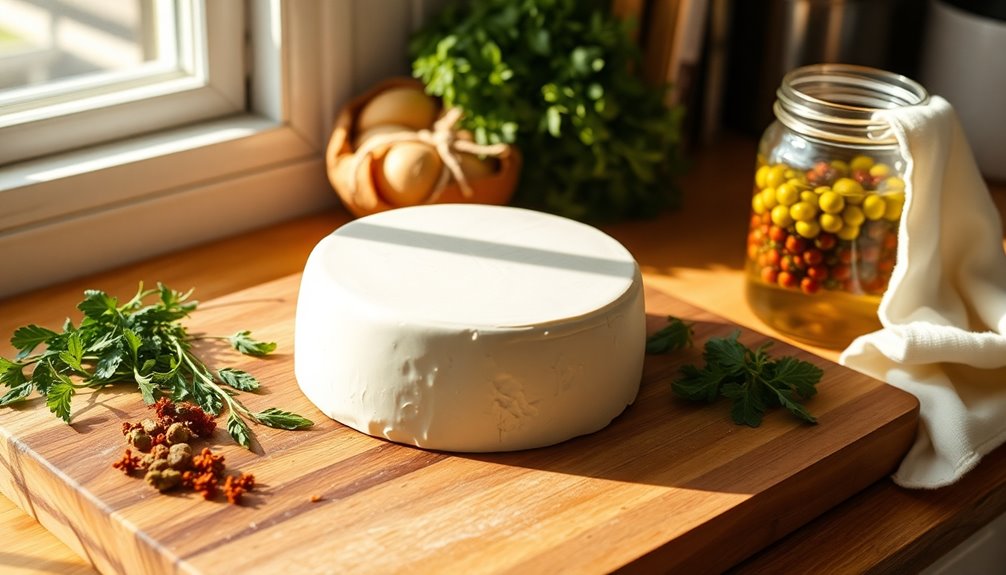
Setting your vegan cheese properly is essential for achieving that perfect final texture and flavor. Once you've blended your ingredients to creamy perfection, it's time to mold and store your cheese. The right conditions can make all the difference, and you'll want to keep a close eye on a few key factors:
- Proper aging: Allow your cheese to age for a few days to develop rich flavors. Don't rush this step; patience brings delicious rewards.
- Temperature control: Maintain a consistent, cool temperature—ideally between 50-60°F (10-15°C). This will promote the right fermentation process without risking spoilage.
- Humidity: Keep the environment slightly humid to prevent your cheese from drying out. A simple trick is placing a damp paper towel in the container.
- Covering: Use a breathable cover, like cheesecloth, to allow airflow while protecting your cheese from dust and contaminants.
Once your cheese has aged to your liking, transfer it to an airtight container for longer storage. It should last about 1-2 weeks in the fridge, ready for your next gathering or cozy night in. You can even freeze it for up to three months, just remember to slice it beforehand for easy access later. Implementing age-old strategies for food preservation can also enhance the quality and longevity of your homemade cheese.
Creative Serving Suggestions
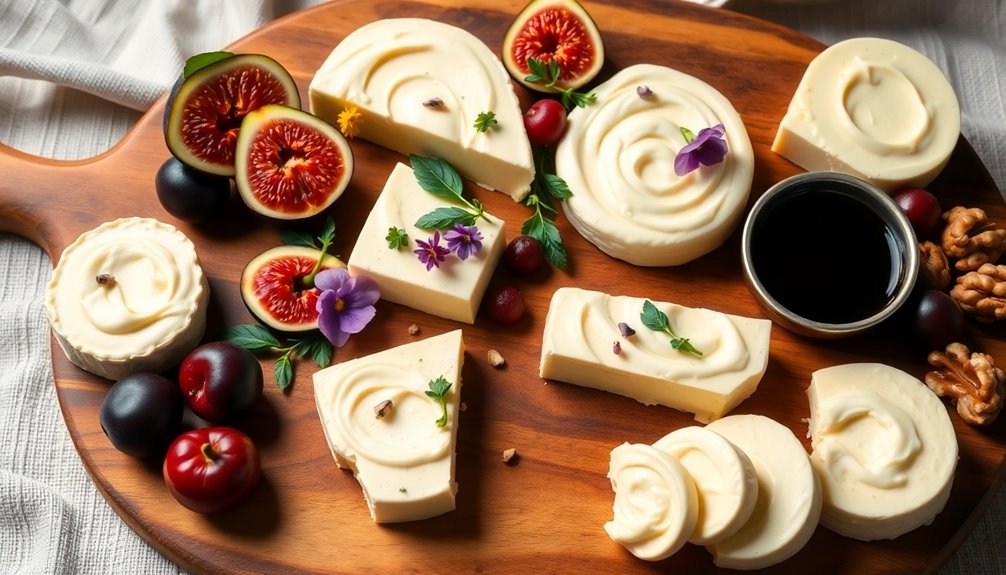
When you want to impress your guests or simply enjoy a delightful snack, serving your homemade vegan cheese in creative ways can elevate any occasion. Imagine a beautifully arranged cheese board, where your creamy vegan cheese takes center stage. Pair it with a variety of colorful fruits, crunchy nuts, and artisanal crackers. This not only makes for a stunning visual display but also invites your guests to explore different flavor combinations. Don't forget to include some fresh herbs and a drizzle of balsamic glaze for an extra touch of sophistication.
You can also use your vegan cheese to elevate your favorite pasta dishes. Stir in dollops of your creamy cheese into a warm bowl of spaghetti, allowing it to melt and create a luscious sauce. Toss in roasted vegetables and a sprinkle of fresh basil for a hearty meal that feels indulgent yet wholesome.
Alternatively, try making a vegan cheese-filled lasagna, layering it between sheets of pasta with rich marinara sauce and fresh spinach.
For a fun twist, consider using your vegan cheese as a dip. Mix it with spices and herbs to create a flavorful spread for fresh veggies or breadsticks. This versatile cheese won't only satisfy your cravings but also impress anyone who takes a bite. By serving your homemade vegan cheese in these creative ways, you'll foster a sense of connection and delight among your friends and family, making each gathering an unforgettable experience.
Troubleshooting Common Issues
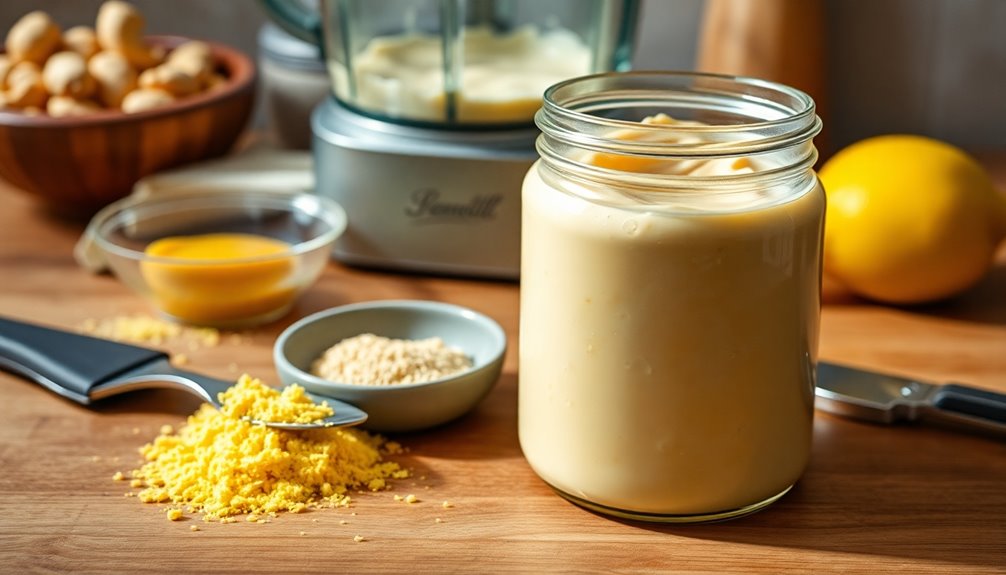
While making your creamy vegan cheese can be a rewarding experience, you might encounter some common issues along the way. Don't let these bumps in the road discourage you; with a little troubleshooting, you can achieve that perfect creamy consistency and flavor that brings everyone together. Here are some common problems and how to solve them:
- Texture Problems: If your cheese is grainy or too thick, try blending it longer or adding a splash of water or non-dairy milk to achieve that silky smoothness. A high-speed blender works wonders!
- Flavor Inconsistencies: If your cheese tastes bland or off, consider adjusting your seasoning. Nutritional yeast, garlic powder, or lemon juice can elevate the flavor profile. Don't be afraid to experiment until it feels just right.
- Separation Issues: If your cheese separates after chilling, it may need a quick remix! Blend it again with a bit of non-dairy milk to bring it back together.
- Overly Tart Flavor: If you find your vegan cheese too tangy, balance it out with a pinch of sweetener or a little more nut base to soften that acidity.
Additionally, remember that snoring can have serious consequences for your health, including linked to sleep apnea, so it's essential to prioritize your well-being while enjoying your culinary creations.
Frequently Asked Questions
Can I Use Non-Nut Alternatives for Creamy Vegan Cheese?
Absolutely, you can use non-nut alternatives for creamy vegan cheese! Think about ingredients like cashew-free cream made from soy or coconut. These options offer delightful flavor variations, allowing you to explore different tastes and textures.
You might even try adding herbs or spices to elevate the flavor. Embrace the creative process and find the combinations that resonate with you – it's a delicious journey that brings a sense of belonging to the vegan community!
How Long Does Homemade Vegan Cheese Last in the Fridge?
Did you know that homemade vegan cheese can last up to two weeks in the fridge? To maximize its shelf life and maintain freshness, store it in an airtight container. Proper preservation is key; temperature fluctuations can spoil your delicious creation faster.
When you're ready to enjoy it, just give it a quick stir. You'll love how versatile it is, making every meal feel special and inclusive for everyone at the table!
Are There Any Recommended Brands for Store-Bought Vegan Cheese?
When you're searching for store-bought vegan cheese, there are several brands worth trying. Daiya offers a creamy texture that many love, while Violife is praised for its authentic taste comparison to dairy cheese. If you prefer a firmer texture, check out Follow Your Heart. Each brand caters to different texture preferences, so you might want to sample a few to find your favorite. Enjoy the journey of discovering your perfect vegan cheese!
Can I Freeze My Homemade Vegan Cheese?
[TEXT]:
Yes, you can freeze your homemade vegan cheese! Just keep in mind that freezing options might alter the texture once thawed. To maintain the best consistency, consider slicing or portioning it before freezing.
When you're ready to use it, allow it to thaw in the fridge. While it may not be as creamy as fresh, it'll still pack plenty of flavor, making it a great addition to your dishes.
Enjoy your culinary creations!
Is Vegan Cheese Suitable for Cooking or Baking?
Imagine a painter blending vibrant colors on canvas; that's what you get when you cook with vegan cheese. It's suitable for baking and cooking, offering diverse flavor options that can elevate any dish.
While its texture may differ from conventional cheese, many find it melts beautifully and adds a creamy touch.
Conclusion
Making creamy vegan cheese at home is not only a fun culinary adventure, but it's also a healthier choice! Did you know that plant-based diets can reduce your risk of heart disease by up to 32%? By following the steps outlined, you can whip up delicious, dairy-free cheese that's packed with flavor and nutrients. So, get creative in the kitchen, and enjoy the satisfying journey of crafting your own vegan cheese that'll impress even the toughest critics!

